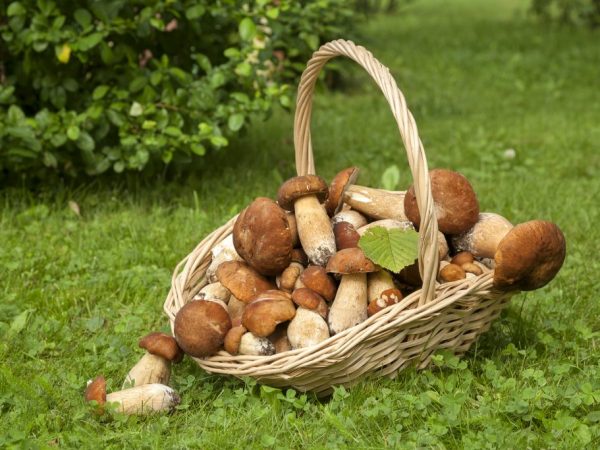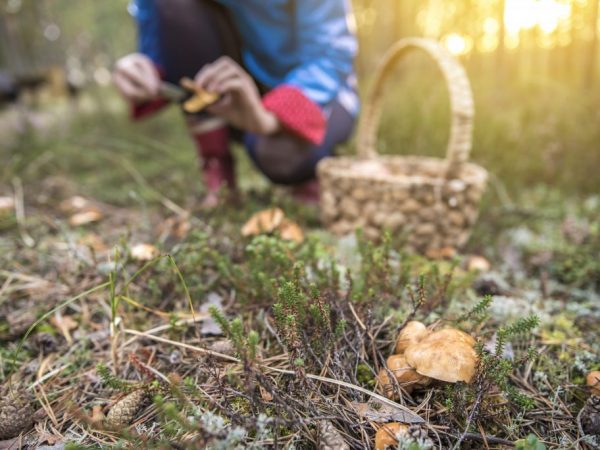Mushroom places
Before a "quiet hunt" you should definitely think over your route. In every forest there are mushroom spots, and there are edges where mushrooms are extremely rare. You also need to know that each mushroom grows in a specific type of area.

Mushroom places
Mushroom places
Many novice mushroom pickers mistakenly believe that they will have to go deep into the forest for the harvest. However, most mushrooms grow on forest edges and small-wooded plantings. Often mushroom families are found on the outskirts of the forest. They also love the shores of shallow streams and grooves. Those who explore the southern edge of the forest are more likely to find a mushroom clearing. Mushrooms often appear along the paths. People, not expecting to see them in these places, simply do not notice the mushroom caps in the grass.
It is not worth exploring the area close to the car park. Fungi absorb everything from the environment, including the exhaust gases of cars. It is undesirable to use such copies.
Irina Selyutina (Biologist):
It has long been noticed that mushrooms are prone to "living" near high-voltage power lines. This is explained quite simply - the trees in the power transmission zone are regularly cut to avoid accidents and this creates favorable conditions for the development of fungi. When choosing directions for conducting your "quiet hunt" try not to forget that mycelium develops more actively in the lowlands, i.e. humid places. The swamps do not belong to this in any way. Air temperature is also an important factor in the formation of fruit bodies. That is why the mushroom season starts later than in the southern regions.
In rainy summers, mushrooms prefer to grow in sunny glades, away from trees. If there is little precipitation in summer, and the air temperature is high, it is worth looking for fleshy hats near the trees. You should also take a closer look at the juniper bushes and places where forest berries grow. It is often possible to find good mushroom families there.
Mushrooms grow on the territory of the so-called "cow" trails. Lands rich in manure, which is one of the best organic fertilizers, are considered the most fertile. Boletus is more common here. Chanterelles also live along the cow paths.
Places without mushrooms
There are places in the forest where mushrooms appear extremely rarely, or do not appear at all:
- You should not feast on the loot collected near the highways. Mushrooms grow well here, but they are rarely organic. By no means always, during heat treatment, it is possible to get rid of all substances harmful to human health that mycelium picks up from the air.
- There are mushroom places prohibited for picking; they are indicated on the map with a special sign. There are mushroom pockets here, and theoretically it seems that it is possible to harvest the harvest. However, either the air and soil in such areas are extremely polluted, or the background radiation is increased.
- You should not look for mushrooms in the forest thickets, going deep into the forest. There, the places of residence of forest gifts are rarely located.
Do not pick mushrooms whose name or appearance is not familiar.Fruit bodies of inedible specimens are often brightly colored. Some edible species also have unusual coloration. Blue leg and chicken mushroom are just a few examples. The fruit body of the first has a pronounced blue tint, and the second is colored yellow.
Features of the search for mushroom places
Before going to pick mushrooms, they think over the route. In order not to waste time, they will find out where to find places in which there are especially a lot of mushrooms. For the first time on a "quiet hunt" you need to go with an experienced mushroom picker. Due to the fact that the mushroom bodies emerge from the mycelium, which yields crops over a long time, the location of the mushroom sites rarely changes. Such information about such areas can be obtained from local newspapers or by looking at the relevant sites on the Internet.
Going into the forest, be sure to take a map of the area. Places where mushrooms are picked are marked on the map. As a result, you will get a map of mushroom places, which will be convenient to use in the future. Plus it will be 100% reliable, which is oh, how important. You will also need a compass with which you can accurately determine the coordinates of the location.
Places of other mushroom pickers should be plotted on the map. At the same time, it is important that the information is obtained from a truly reliable source.

You can make a map of mushroom places yourself
Of all the types of mushrooms, only a few grow alone, without forming a group. If you carefully examine the place where at least one mushroom was found, you will be able to collect a whole basket in a small area. The main thing is to choose the right direction of the route. It is better to look for fruiting bodies, moving in a spiral. This is due to the fact that the mycelium (mycelium) grows in all directions. They also use a scheme called a "comb". It works well in man-planted forests where trees grow in rows. The comb method involves studying the area between each pair of trees located in the same row. The mushroom picker moves on to the next row after having examined all the trees from the previous row. The array is also examined by the zigzag method. In one pass, it will be possible to inspect 2 rows at once, moving in the direction from the first tree of one row to the second tree of the second row, then to the third tree of the first row, etc. The main thing is that you are satisfied with this search method.
Important points
Before looking for mushroom sites, it is better to determine which specimens are found in certain forests. Some of them grow exclusively in coniferous forests, others will have to be looked for in deciduous ones. There are also a number of varieties that are found nearby certain trees (boletus, boletus, white, spruce, etc.). Honey meadows are located near the stumps. Honey mushrooms are best collected in the area of felling.
To return with a large harvest of mushrooms, they go on a "quiet hunt" no later than 6 am. At this time, the mushroom caps are covered with dew, which glistens in the sun and makes them more visible. As soon as the dew disappears, the mushrooms that are hiding in the grass become less visible.
Fruit bodies on the mycelium grow quickly again, so the mushroom card is used throughout the season. They return to the same places every 2-3 weeks. It is best to harvest after rain.
Irina Selyutina (Biologist):
If the summer or autumn has turned out to be dry, you should not immediately go for mushrooms as soon as they appeared after the first rains: it is highly likely that the vegetative body of the fungus (mycelium) absorbed toxic compounds that got into the soil with rainwater. Wait for the next rain.
To get a full basket of forest resources, you need to go to the forest in the second half of summer or closer to autumn. Some varieties begin to be harvested as early as late spring. However, fungal families are rare during this time. Sometimes you can't find anything at all.
Before going into the forest, you should stock up on a sharp knife, just do not take large kitchen ones. With a knife, you can carefully cut off the mushroom, if necessary, clean the leg from damage or sprinkle the place of growth of the fruiting body to protect it from drying out.
Folk omens
To collect a specific type of mushroom, you should listen to folk signs:
- To feast on porcini mushrooms, you will have to go to pine or deciduous forests. More often boletus grows in birch groves. It appears in early May. According to folklore, the boletus begins to grow en masse 10-14 days after the appearance of the chanterelles.
- Butterlets are found in coniferous forests. Coniferous needles are their favorite habitat. The most delicious crop is considered to be harvested in mid-September. Young pine plantings prefer boletus.
- A sure sign that it's time to go to the forest is the appearance of midges on the forest edges. If, during a forest walk, places with a large amount of mold are found, then it is worth returning here in 7-12 days to pick a full basket of mushrooms.
- You should not bypass the side of the glades, where you can meet fly agarics. Often there is a place with porcini mushrooms nearby.
- It will be possible to determine whether it will be possible to gain forest riches in the summer even before the opening of the season. If a quiet night is issued for Epiphany, and a large number of stars are visible in the sky, then in the summer it will turn out to feast on all varieties of mushrooms, especially white ones.
- It is worth going or going to the forest even if butterflies are swarming over the fields.
Conclusion
Gathering mushrooms is required carefully, carefully examining each new specimen before sending it to the basket. Even one inedible mushroom poses a deadly threat to humans. Before you go on a "quiet hunt", you will have to find out where the greatest number of mushrooms grows. On the territory of Russia, all forests are rich in mushrooms and berries. To collect a complete basket of forest resources, you do not have to go far from the station or parking lot. Sometimes it is enough to explore the outskirts of the forest, taking a southerly direction.


